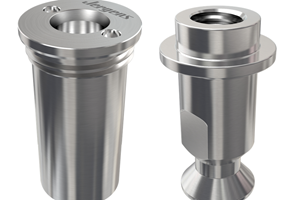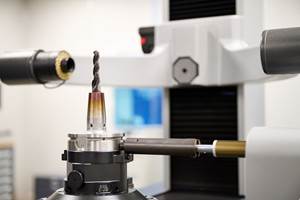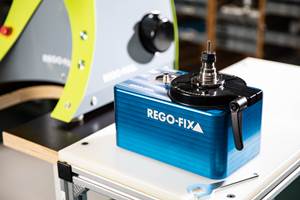Toolholders Fuel Setup Time Reduction
This Indiana shop has been a precision automotive parts supplier to Honda America since it began operations in 1988. Among its precision machined products are fuel intake manifolds for Honda Civics, Accords and V6 sport utility vehicles. IPT produces 4,000 of these manifolds in a 24-hour workday, die casts these manifolds and does all finish machining and testing in-house.
Indiana Precision Technologies (IPT) in Greenfield, Indiana, has been a precision automotive parts supplier to Honda America since it began operations in 1988. Among its precision machined products are fuel intake manifolds for Honda Civics, Accords and V6 sport utility vehicles. IPT produces 4,000 of these manifolds in a 24-hour workday, die casts these manifolds and does all finish machining and testing in-house.
The company was looking for a way to reduce its setup time on the diamond reamer used to machine fuel rails in automotive fuel intake manifolds. The fuel rail port through which fuel is injected in these intake manifolds requires a 3.2-micron surface finish to provide accurate fuel flow for top engine performance. Although the machining was achievable, the problem occurred when tool replacement was needed. Accurate tool resetting would take anywhere from an hour and a half to eight hours of trial and error to get the diamond reamer to produce the desired finish. With 28 CNC machining centers, IPT’s volume requirements for the manifolds grew, and tool setup time loomed as a problem.
“We became interested in Command Tooling System’s (Ramsey, Minnesota) new shrink fit toolholder technology as a possible solution when it was introduced to us by our toolholder dealer, Dolen Tool Sales,” says Rod Humphries of IPT. “David Dolen and Command’s representative, Marty Welch, felt that because of our high finish and volume requirements, a test of Command’s ThermoLock toolholders could substantially reduce runout time and eliminate the tedious tool setups of the diamond reamer.”
IPT’s continuous improvement program requires a one-year payback on major equipment acquisitions. Mr. Humphries believed a toolholder switch could accomplish the setup time reduction and extend tool life. If successful, the investment of the toolholder switch would fall well within IPT’s 12-month payback requirement.
To get started with the test, Mr. Humphries purchased four custom BT30 ThermoLock toolholders, two to hold the 85 mm/length twist drills for tapping the fuel rail underholes and two to hold the 160 mm/length diamond reamers for the finishing operation. (Twist drill inside diameter was 12 mm. Diamond reamer inside diameter was 13 mm.) Mr. Humphries shipped twist drills and reamers to Command for loading into the new toolholders. This was necessary since an induction heating machine was needed for correct tool setup in the holders.
Unlike conventional toolholders, which have set screws or collets for tightening, Command ThermoLock toolholders with Shrinker technology are heated to load and unload the cutting tool. They have no setscrews or collets. Rather, they are slightly undersized relative to the cutting tool being used. When placed in a special heating unit, the holder nose inside diameter expands to accept the cutting tool. When cooled, the holder nose inside diameter shrinks back to its original undersized dimension. The result is gripping power over the full length of the holder/cutting tool interface. This shrink fit method provides an ideal total indicator readout level (TIR) and 360-degree concentric gripping power in the toolholder. For removing the tool, the setup process is simply reversed.
Upon receipt of IPT’s twist drills and diamond reamers, Command placed the new BT30 toolholders in one of its Induction Tool Changers, made the proper power setting selection, initiated the heating cycle and inserted the tools to the specified length. In seconds, the tools were locked into position and ready for shipment.
IPT ran its test using the four different size custom ThermoLock BT30 toolholders for a period of six weeks on all shifts. The important tool—the diamond reamer—was operated at 4,300 rpm with a seating feed rate of 473 mm per minute.
“The results were outstanding,” says Mr. Humphries. “Using the conventional collet chucks, we averaged 16,500 parts with three holes in each over a 13-day period. With Command ThermoLock toolholders, for the same three-week period, we averaged 92,500 finished parts. We basically tripled our tool life on the diamond reamers. We found the perfect toolholder with the most repeatable machine interface. Both of our tests were done within what we consider a ‘safe zone.’ In other words, we actually change tools before they are dull or fail. We calculate their life based on manufacturer information, previous usage and experience. Then, we backup 15 percent from that. It gives us a ‘safe zone’ so that we don’t damage tools or make scrap unnecessarily. It also allows us to make the tool changeover at a convenient time such as at the end or beginning of a shift.”
According to IPT, the setup time issue became a moot point because the toolholders were set accurately at Command with an induction heating machine. IPT’s operators only needed to load them into the magazine and turn on the switch, and runout was accurate from the beginning. Mr. Humphries says he and his management were satisfied with the test and its cost/payback projections, which they calculated at less than 6 months.
Related Content
How to Troubleshoot Issues With Tool Life
Diagnosing when a tool is failing is important because it sets an expectation and a benchmark for improvements. Finding out why gives us a clue for how to fix it.
Read MoreJergens Pull Studs Enable Quick Changeovers
SP140 and K02 pull studs offer quick-change solutions for vise or gripper jaws, electronic component manufacturing, packaging machines, medical technology and automation.
Read MoreSimulation and Tooling Secure High-Value Work
Simulation software and careful attention to tooling parameters have enabled Major Tool to take on ambitious projects with its complex machinery.
Read MoreFive Common Mistakes Shops Make with ER Collets (And How to Prevent Them)
Collets play a crucial role in the machining process, so proper tool assembly and maintenance is important. Here are five potential pitfalls to avoid when using ER collets.
Read MoreRead Next
The Cut Scene: The Finer Details of Large-Format Machining
Small details and features can have an outsized impact on large parts, such as Barbco’s collapsible utility drill head.
Read More3 Mistakes That Cause CNC Programs to Fail
Despite enhancements to manufacturing technology, there are still issues today that can cause programs to fail. These failures can cause lost time, scrapped parts, damaged machines and even injured operators.
Read More

























